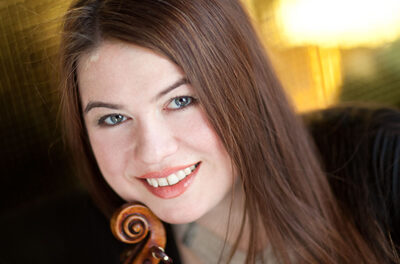Music from composers active in late 18th century-early 19th century Austria — the “heavy hitters” of the era and the region — made up the final program in the Raleigh Symphony Orchestra’s 2011-12 Season, played before a surprisingly small audience at Meredith College. The orchestra, conducted by Jim Waddelow, was joined by two of its principals for solo turns.
Concertmistress Tasi Matthews displayed lovely tone and fine command of Beethoven’s Romance No. 2 in F, Op. 50, a beautiful shorter piece for violin and orchestra. The orchestra provided a nice ensemble sound, especially in the strings, to support Ms. Matthews, who negotiated fast fingering demands and occasional dramatic intervals quite well. Her sound was full but not overbearing, and she played the softest passages without a hint of dryness or thinness.
Principal French horn player Mary Pritchett Boudreault was the soloist in Mozart’s Horn Concerto No. 3 in E-flat, K. 447. Again, the orchestra provided good support for the soloist, and the blend of soloist and orchestra in the second romanza movement, one of Mozart’s simpler and lovelier melodies, was especially fine. Ms. Boudreault handled the solo parts with skill, with infrequent and only minor missteps. She did not display fireworks in the cadenza of the opening allegro movement, instead playing a relatively simple repeat of the main melody line. The final movement was quite lively, with its familiar opening line and nice exchanges between soloist and orchestra. The overall “feel” to this movement (and perhaps the piece as a whole) was that of a jovial riding or hunting song, with little tension or drama interjected; the slower second movement could be interpreted as a relaxing respite during the hunt. Ms. Boudreault’s tone lacked the fluid mellowness one often hears in solo horn lines, but she gave a generally good reading of this piece.
The concert opened with the overture to Il Re Pastore, an opera Mozart wrote when he was 19, and Waddelow showed that he would not cut the players any slack just because they are a community orchestra. The tempo started out fast and remained fast and crisp throughout the brief piece. Slight imprecision in timing, mainly in the strings, corrected themselves by the end.
Two symphonies also were on the program, Haydn’s No. 63 in C, called “La Roxelane,” and Schubert’s No. 5 in B-flat. In the Haydn work, the opening allegro movement has a martial sense to it, but it also included a section of dramatic tension leading to a repeat of the opening theme. The second allegretto movement sounded almost like a child’s song in strongly measured dance rhythm, while the third movement actually is a minuet. The second movement, almost a theme and variations, featured nice alternating progressions from minor key to major and back and forth, while the third menuetto movement included a lovely and lengthy oboe solo line over bassoon and pizzicato strings. The finale was quite bright and lively.
The best playing of the evening came in Schubert’s symphony. Although his so-called “Unfinished” symphony or the “Great” or “Tragic” symphonies might be better known, this work, written before Schubert turned 20, is chock-full of familiar melodies — each movement could be part of a “greatest hits” anthology. The opening allegro movement has an overall lighthearted tone, mixing delicacy and sunshine, and the players imparted this feeling well. The second andante con moto movement was especially lovely, with lush strings and subtle winds combining for a gorgeous sound. The third movement, marked menuetto, had a darker and more forceful feeling. It seemed anything but a dainty ballroom dance, at least in the opening bars, with the familiar 10-note figure that recurs twice before the end. The final allegro vivace movement was joyful, tuneful and brisk; a few paces short of a horserace, but handled quite nicely by the players.
The concert material certainly was pleasing, and the orchestra’s performance was solid, if not outstanding. The imprecise timings noted in the opening piece also carried over into pitch and tone on a few occasions during other parts of the program, but when things came together, as in the Schubert symphony, the sound was fine, even splendid, and the orchestra certainly adds considerably to the cultural and artistic wealth offered in the Triangle.












